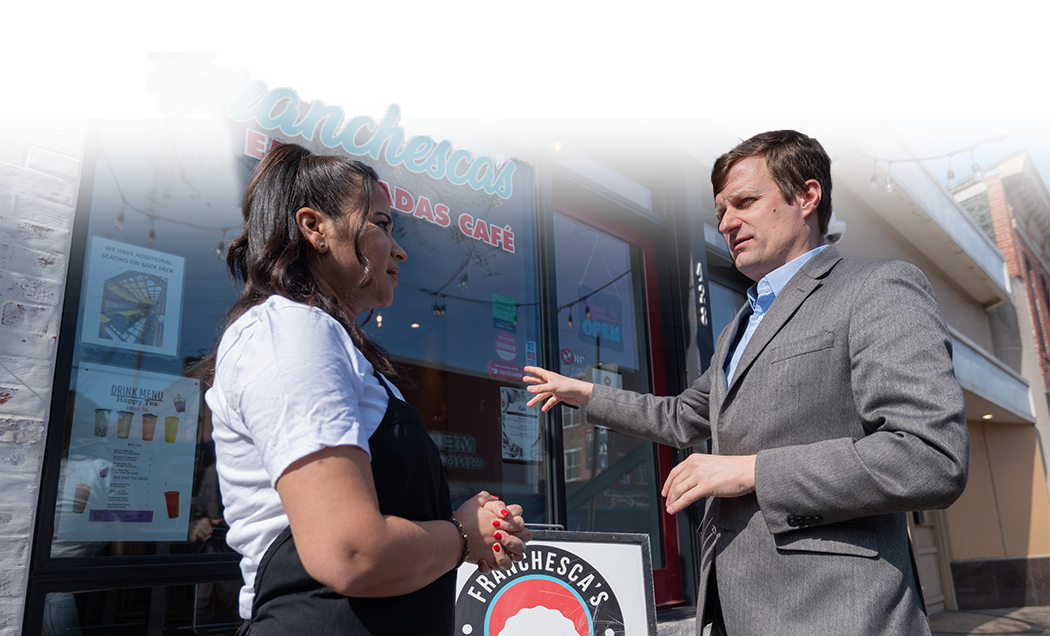
Vision & Values:
Access to high-quality and family-supporting jobs is critical for the well-being of city residents; businesses need to have clear pathways and support as they launch and as they expand in our district.
Leadership & Experience:
I am a long-standing leader in the Southeast Youth Collaborative, a group of local nonprofit organizations which have collectively employed more than 1,000 youth in engaging and community-facing summer jobs.
I have supervised summer YouthWorks participants for the past seven summers, supporting them in their first professional experiences and helping them grow as leaders.
Through my service on the SECDC board of directors, and my work alongside their staff, I’ve been engaged with and supportive of the Highlandtown Arts District and the Highlandtown Main Street program.
I have testified on many occasions and come alongside neighbors and local businesses to advance important projects in front of the Planning Commission, the Board of Municipal Zoning and Appeals, and the Liquor Board.
I helped to support the labor organizing effort at Johns Hopkins Hospital for the National Nurses United, providing connections to nursing staff, hosting meetings, and making community connections.
Priorities:
Neighborhood Commercial Districts:
A great strength of the 1st District are our neighborhood commercial districts, including Greektown, Canton, Highlandtown, and Fells Point. These include our two official Main Street programs (Fells Point and Highlandtown), and the Highlandtown Arts & Entertainment District. Unfortunately, these Main Street programs have been slowly starved for resources, often existing without the capacity and leadership to fully support the businesses in their district. The recent doubling of city funding for our main street programs is an encouraging development. The shift in focus by the Baltimore Development Corporation in recent years from huge downtown/waterfront projects to supporting neighborhood commercial operators (with an eye toward equity) needs to be continued and supported. The State of Maryland Project Restore program is a great tool for redeveloping current vacant commercial spaces in our area. Improvements to our unreliable and inefficient construction permit process are also necessary to smooth the way for commercial expansion and renewal in our district.
Employment Transportation:
Safe, reliable, and affordable means of accessing significant employers is necessary to maximize individual opportunity and further economic development. The Red Line (with connections to Bayview, Social Security, and downtown areas) will do much to increase our capacity to connect people with work. A Bayview MARC station would significantly expand the ability of local residents to commute to Washington and to Aberdeen. Expanded transit service to the high-growth industries associated with the Port of Baltimore and Tradepoint Atlantic will be vital as we seek to connect East Baltimore residents with those jobs.
Staff Recruitment and Training:
Major employers (especially in port-related industries) struggle to find local residents able and prepared to work in high-compensation and rewarding positions. We need to strengthen the connections between these employers and young residents, particularly through Patterson, Dunbar, and Cristo Rey high schools, and through BCCC. The vocational training programs and facilities at Patterson are robust—but the partnerships with local employers like Bayview and the Port are lacking. Construction trade unions, the ILA, the Teamsters, and others should be encouraged in developing better training partnerships with local schools. Both unions and employers should be urged to increase their participation and commitment to YouthWorks (especially in the more substantial, year-round version of the program).
Industrial Zoning and Transportation Corridors:
The 1st District is home to significant industrial and manufacturing activity, spread throughout many of our neighborhoods, in our industrial zones, and along the Patapsco River. For the sake of continued economic development and employment growth, this land use needs to be protected from residential encroachment. The Maritime Industrial Zoning Overlay District is one important tool to protect industrial land use. Similarly, truck routes and railroad right of ways are vital for the daily functioning and productivity of these businesses—and deserve protection.
Opportunities & Protections for Immigrant & Refugee Neighbors:
Immigrant and refugee neighbors have specific challenges which need to be addressed. These persons are particularly vulnerable to abuse, harassment, and violence in the workplace. Wage theft is common, particularly towards undocumented persons. Workplace injuries occur frequently, and without the necessary insurance to compensate individual employees and to support their families as they recover. There is a role for the Office of Civil Rights and the Mayor’s Office of Immigrant Affairs in advocating for and protecting these communities. Furthermore, we need more aggressive enforcement from the office of the Attorney General of Maryland. Additionally, English language education for newly-arrived adults needs to be significantly expanded and offered at more accessible rates. This is a major impediment to their employability and their ability to function effectively in the community. Helping and pushing refugee resettlement organizations to develop better pathways to employment and career-building for their clients is important for helping those individuals and their families start well and have opportunities to build a career. Finally, access to affordable and reliable credit for business creation and expansion (like that offered through the Latino Economic Development Center, with an office here in the district) is significant for individuals, their businesses, and the economic vitality of our district.
